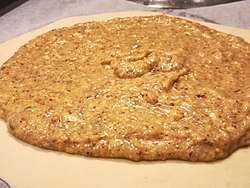Frangipane
 Frangipane cream before baking | |
| Type | Custard |
|---|---|
| Main ingredients | Almonds or almond flavouring, butter, sugar, eggs |

Frangipane (/ˈfrændʒɪˌpæn,
Today it is normally made of butter, sugar, eggs, and ground almonds.
In some anecdotes it was the kind of sweet that the noblewoman Jacopa da Settesoli brought to St. Francis of Assisi in 1226, when he was dying.
On Epiphany, the French cut the King Cake, a round cake made of frangipane layers into slices to be distributed by a child known as le petit roi (the little king) who is usually hiding under the dining table.[3] The cake is decorated with stars, a crown, flowers and a special bean hidden inside the cake.[4] Whoever gets the piece of the frangipane cake with the bean is crowned “king” or “queen” for the following year.
Etymology
Frangipane/frangipani derived from frangere il pane from which the noble Frangipani family of Rome derived its name in the 11th century. A certain Frangipane was perfumier to Louis XIII of France, hence the common name of the flowering tropical trees that are actually in the genus Plumeria. Other people believe it's derived from St. Francis; pane is Italian for bread and Frangi would have been the cognomen of St. Francis.
See also
References
- ↑ Kitchen Dictionary Retrieved 14 May 2013
- ↑ Frangipane recipes at BBC Food Retrieved 14 May 2013
- ↑ Frangipane at BBC Good Food Retrieved 24 May 2013
- ↑ Mary Berry’s Christmas recipes: Mincemeat Frangipane Tart at Telegraph UK Food and Drink Retrieved 14 May 2013
Bibliography
- "Frangipane." Oxford Companion to Food (1999), 316.